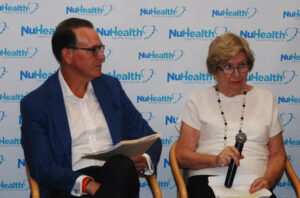By Dorothea Armijos
For the second time since the start of the coronavirus pandemic in March 2020, Saint Mark Coptic Church in Woodbury hosted its annual Egyptian festival, celebrating and teaching about the diverse culture of Egypt and its Christian community.
The word Coptic comes from the ancient Greek for Egyptian, but many Egyptians are unaware of the word’s origin, according to the Rev. Guriguis Tadros, of St. Mark Church. The Coptic Christian faith began around 50 A.D. in Alexandria, Egypt’s second-largest city after Cairo, and a small number of Coptic Christians remain in the now primarily Muslim nation. Saint Mark brought Christianity to Egypt. Coptic Christians are among the biggest minorities in the Middle East today.
“We prepare for [the festival] months in advance,” said Katerin Mikhaeil, a member of the church and festival committee. “Usually everybody in the neighborhood goes and gives out fliers to anybody that wants to come and see our church.”
Marlin Soliman has been a member of St. Mark for six years and the festival committee for two. “Every three years, they change the committee, which is great…It gives people new ideas and new thoughts,” she said.
The festival is an immersive cultural experience, including a tour through the church’s chapel, a show and exhibit with Egyptian pyramids, and homemade Egyptian dishes. There are various interactive cultural displays, traditional music and children’s activities. The festival is advertised on the church’s Twitter, Facebook and Instagram pages.
“We have a photo booth where people dress up as Egyptians, and then they take pictures,” Soliman said.
On the tour inside the chapel, a priest gives the history of Egypt. Inside, there is religious art such as paintings, stained-glass windows and shrines. Guriguis dove into Egypt’s religious history, covering the expansion and history of Coptic Christianity in the Middle East, Egypt’s saints, the historic periods before and after Roman persecution, and the teachings and ways of the church.
“A parish priest has to be married. We’re very traditional. This is the old tradition,” Guriguis said. “Since I’m going to serve families, I’m going to take their confessions, I’m going to be their counselor, then I have to be one of them.”
The reverend must also must be a professional. “I was a physician in Egypt before being a priest,” Guriguis said. “Father Moussa was an accountant, Father Joseph was a pharmacist in CVS. We have our family, our children, so people choose a family man to be the priest.”
Along with the tour, there is a show that teaches the audience about Egypt’s long and storied history. “This is like the biggest highlight of the festival,” Soliman said.
A 15-minute-long interactive show also takes audiences inside King Tut’s tomb, along with Egyptian pyramids, temples and churches, and features a great deal of art.
At the end of the show, there is a small exhibit full of artifacts that are put up for auction.
“We do a lot of activities, mystery gifts, inflatables, and more kids are coming to do activities here, painting, hair braiding, nail polish,” Soliman said.
The biggest attraction at the St. Mark festival is undoubtedly the authentic Egyptian cuisine, served at three food stations. The first is inside the church near the front entrance, serving kobeiba, koshary, moussaka, kebabs and grape leaves. Outside the main entrance is a station serving shawarmas, made on the spot. In a tent by the bouncy house is a dessert station, with fresh baklava, basbousa, kunafa and kahk.
“My favorite part?” Mikhaeil asked. “Definitely the food.”









